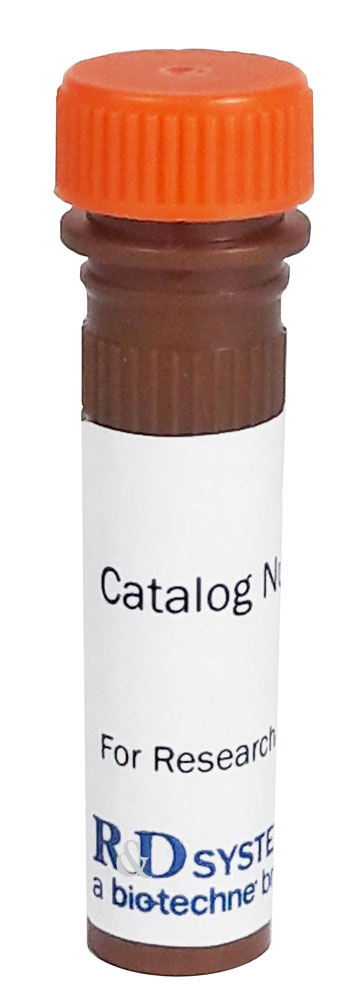Human GDF-9 Alexa Fluor® 750-conjugated Antibody Summary
Met1-Arg454
Accession # O60383
Applications
Please Note: Optimal dilutions should be determined by each laboratory for each application. General Protocols are available in the Technical Information section on our website.
Reconstitution Calculator
Preparation and Storage
Background: GDF-9
Growth Differentiation Factor-9 (GDF-9) is an oocyte secreted paracrine factor in the TGF-beta superfamily (1, 2). It is synthesized as a prepropeptide and is subsequently processed by proteases into the mature protein (1, 2). Mature human GDF-9 has a predicted molecular weight of 16 kDa and shares 89.6% and 91.9% amino acid sequence identity with the mouse and rat orthologs, respectively. Despite the high homology, mouse GDF-9 is secreted in an active form, while human GDF-9 is latent. A single mutation Gly391Arg increases the affinity between human GDF-9 and its signaling receptors and make it more active (3). It forms both non-covalent homodimers and heterodimers with BMP-15, which is coordinately expressed with GDF-9 in the oocyte. (2, 4, 5). GDF-9 signals through TGF-beta RI/ALK-5 and BMPR-II, while the GDF-9:BMP-15 heterodimer is believed to signal through BMPR-II, ALK 4/5/7, and BMPR-IB/ALK-6 (5-8). SMAD2 and SMAD3 are phosphorylated following activation of receptor complexes by GDF-9 (5, 6). GDF-9 functions as a paracrine factor in the development of primary follicles in the ovary. It is critical for the growth of granulosa and theca cells and for the differentiation and maturation of the oocyte (5, 9-11). GDF-9 is thought to act synergistically with BMP-15 to control development of the oocyte-cumulus cell complex (4-6). In humans, GDF-9:BMP-15 heterodimers have been shown to be more potent regulators of granulosa cell functions compared to GDF-9 homodimers (6). Aberrant GDF-9 expression and activation is associated with a multitude of common human ovarian disorders including premature ovarian failure and polycystic ovary syndrome (10, 12-14). In breast and bladder cancers, GDF-9 is believed to function as a tumor suppressor because its expression levels are inversely correlated with the aggressiveness of the cancer (15, 16). In prostate cancer, however, GDF-9 may enhance tumor progression by promoting tumor cell growth and epithelial-to-mesenchymal transition (17, 18).
- McGrath, S. A. et al. (1995) Mol. Endocrinol. 9:131.
- Aaltonen, J. et al. (1999) J. Clin. Endocrinol. Metab. 84:2744.
- Simpson, C.M. et al. (2012) 153:1301.
- Liao, W.X. et al. (2003) J. Biol. Chem. 278:3713.
- Gilchrist, R.B. et al. (2008) Hum. Reprod. Update 14:159.
- Peng, J. et al. (2013) Proc. Natl. Acad. Sci. USA 110:E776.
- Vitt, U.A. et al. (2002) Biol. Reprod. 67:473.
- Mazerbourg, S. et al. (2004) Mol. Endocrinol. 18:653.
- Hreinsson, J.G. et al. (2002) J. Clin. Endocrinol. Metab. 87:316.
- Otsuka, F. et al. (2011) Mol. Reprod. Dev. 78:9.
- Dong, J. et al. (1996) Nature 383:531.
- Zhao, S.Y. et al. (2010) Fertil. Steril. 94:261.
- Wei, L.N. et al. (2011) Fertil. Steril. 96:464.
- Simpson, C.M. et al. (2014) J. Clin. Endocrinol. Metab. [Epub ahead of print].
- Hanavadi, S. et al. (2007) Ann. Surg. Oncol. 14:2159.
- Du, P. et al. (2012) Int. J. Mol. Med. 29:428.
- Bokobza, S.M. et al. (2010) J. Cell. Physiol. 225:529.
- Bokobza, S.M. et al. (2011) Mol. Cell. Biochem. 349:33.
Product Datasheets
Product Specific Notices
This product is provided under an agreement between Life Technologies Corporation and R&D Systems, Inc, and the manufacture, use, sale or import of this product is subject to one or more US patents and corresponding non-US equivalents, owned by Life Technologies Corporation and its affiliates. The purchase of this product conveys to the buyer the non-transferable right to use the purchased amount of the product and components of the product only in research conducted by the buyer (whether the buyer is an academic or for-profit entity). The sale of this product is expressly conditioned on the buyer not using the product or its components (1) in manufacturing; (2) to provide a service, information, or data to an unaffiliated third party for payment; (3) for therapeutic, diagnostic or prophylactic purposes; (4) to resell, sell, or otherwise transfer this product or its components to any third party, or for any other commercial purpose. Life Technologies Corporation will not assert a claim against the buyer of the infringement of the above patents based on the manufacture, use or sale of a commercial product developed in research by the buyer in which this product or its components was employed, provided that neither this product nor any of its components was used in the manufacture of such product. For information on purchasing a license to this product for purposes other than research, contact Life Technologies Corporation, Cell Analysis Business Unit, Business Development, 29851 Willow Creek Road, Eugene, OR 97402, Tel: (541) 465-8300. Fax: (541) 335-0354.
FAQs
No product specific FAQs exist for this product, however you may
View all Antibody FAQsReviews for Human GDF-9 Alexa Fluor® 750-conjugated Antibody
There are currently no reviews for this product. Be the first to review Human GDF-9 Alexa Fluor® 750-conjugated Antibody and earn rewards!
Have you used Human GDF-9 Alexa Fluor® 750-conjugated Antibody?
Submit a review and receive an Amazon gift card.
$25/€18/£15/$25CAN/¥75 Yuan/¥2500 Yen for a review with an image
$10/€7/£6/$10 CAD/¥70 Yuan/¥1110 Yen for a review without an image


